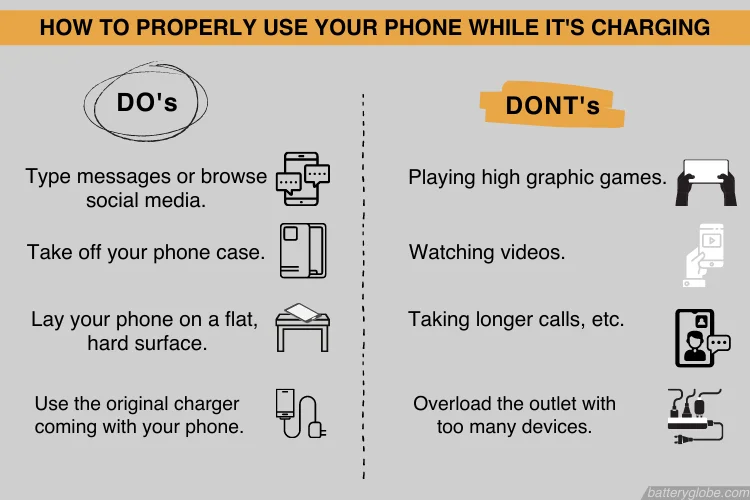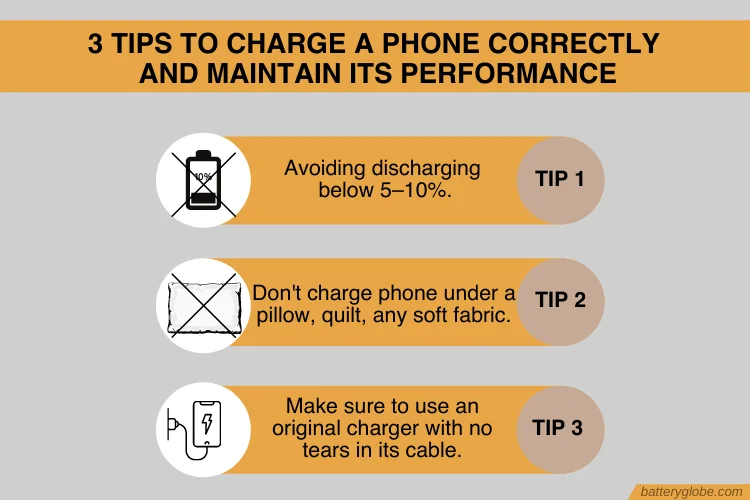Is it bad to use your phone while it’s charging? Some people say using your phone while charging can overstress the battery, causing damage and reduced lifespan.
But is that true? Let’s explore the evidence and find out what you should do to get the most from your smartphone battery.
Is it bad to use a phone while charging?
If you’re using your phone while it’s charging, don’t worry – you’re safe. This is a common practice and very safe.
Just be careful not to let your phone get too hot. Excessive heating can cause component overheating, and you don’t want that. Another minus is that you’re burning some of your battery cycles.
Therefore, if your phone becomes uncomfortably hot when you’re charging it, then you should quit using it.
Do you want to know what you can and cannot do with your phone while it’s being charged? Continue reading for further information.

DO
- You can type messages or browse social media while your phone is charging.
- Make sure to take off your phone case, as it can affect heat dissipation.
- Lay your phone on a flat, hard exterior to help it cool down.
- Use the original charger that came with your phone for the best results. An incorrect or unknown charger might not deliver an adequate charging current or fulfill safety standards.
DON'T
- Do not use your phone for some heavy tasks while on charge. They all heat the battery of your smartphone.
- Playing high graphic games.
- Watching videos.
- Taking longer calls, etc.
- Do not overload the outlet with too many devices. Charging a phone and another device at the same time can overload the outlet and cause problems with both devices.
Is it possible that using a phone while charging is the reason for the devastating explosions?
Recall terrifying explosions from Samsung Galaxy Note 7
As phone users, it’s essential to be aware of the exploding battery issue with the Samsung Galaxy Note 7. This issue has caused phones to burst into flames or explode, and so far, there have been reports of 92 incidents in the United States alone.
While the problem has been addressed with a recall, it’s essential to be aware of the potential danger.
The problem seems to be with the lithium-ion batteries that power most smartphones. These batteries are generally very safe to use, but they can be dangerous if they’re discharged in an uncontrolled way.
The worst-case scenario is a thermal runaway, leading to the battery bursting into flames or exploding.
So, what is the main reason?
Samsung has released a statement saying that the explosions were caused by two distinct battery makers, manufacturing and design flaws.
The problems were due to insufficient insulation material within the batteries and a design that did not give enough room to accommodate the batteries’ electrodes safely.
Is it possible that the cause of the explosion was because you were using your phone while charging?
There’s no need to worry about charging your phone while it charges!
The lithium-ion battery has a built-in circuit (Battery Management System IC) to prevent overcharging and overheating.
You can use your phone or any other gadget while it’s charging – the internal protection will prevent anything wrong from happening!
A few cases of unusual outcomes do exist, such as with Samsung Note 7 and iPhone 6s Plus smartphones- but these issues are scarce indeed!
Is it dangerous to fast charge your phone while using it?
It’s a question that’s been debated for years: Is it dangerous to fast charge your phone while using it?
Some people say that it is because you’re overworking the battery. Others say that it doesn’t make a difference. So which is it?
Charging your phone with rapid charge is SAFE if you follow these guidelines:
- Don’t charge your phone at a wattage that is too high; this will cause the charging rate to go crazy (50w, 60w, or even 120 watts). Avoid using a charger with more than 20 watts for gaming and calling reasons.
- Don’t charge your phone from zero battery, as this can reduce its lifespan. Instead, keep the battery above 15–20% every day.
- Only charge your phone while using it with a reputable company’s charger. Third-party chargers also tend to be poorly made, leading them to malfunction, causing fires or other dangers in some cases.
- Wireless charging is a safer way to charge your phone. This is valid for all mobile phones, not just the fast charging ones.
Tips to charge your phone correctly to maintain its performance
- Avoiding discharging below 5–10%. Those who keep their phones within the optimum range of 20% to 80% will experience maximum battery life.
“Never run a battery to zero. That’s bad for it”
“The rule of thumb: To get your smartphone battery to last the longest, charge it to 80% and recharge it when it hits 20% to avoid stressing the system.”
Carl Howeformer, mobile analyst and Principal of Think Big Analytics.
- Be careful when charging your phone! Don’t charge it under a pillow, quilt, or any soft fabric because the battery will heat up too much and may start burning.
- Make sure that you’re using an original charger with no tears in its cable; if anything happens, stop use immediately as there could be potentially dangerous consequences for both yourself as well as others around them.

Conclusion
No evidence using a phone while charging will damage the battery. Most phones are designed to allow users to continue using the device while charging.
That said, there are still some risks associated with using a phone while charging. For example, if you use your phone while it’s plugged in and playing high graphical games or watching videos.
So, if you’re worried about damaging your battery, it’s best not to use your phone while it’s charging. But if you need to make a call or answer a text, go ahead.
